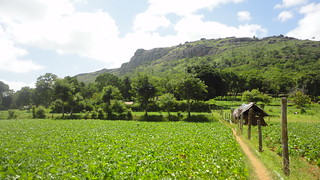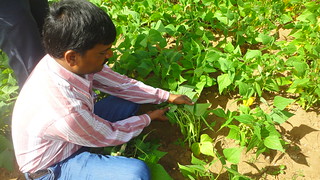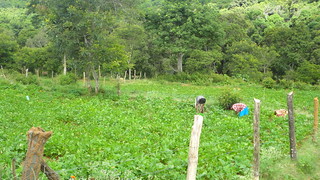Breaking away from routine is not an easy task. The case with farmers is no different. Our village of interest, Bejaletti in Erode district, is dominated by Sholigas tribals, where farmers mainly engage in agricultural activity for almost 6-7 months of the year. Myrada Krishi Vigyan Kendra, in a bid to improve the farm income and nutritional security of the villagers, introduced the small orchard development and beans intercropping which transformed more than just the landscape of the village.

Beans crop before harvest in Bejaletti village, Erode (Photo: Seetha Gopalakrishnan)
Ragi and maize are the staple Kharif crops. Initially, the Sholigas used to cultivate Ragi as the main crop along with lab lab and mustard as inter-crops. The area is completely rain-fed. After the Kharif harvest in January it is common practice for tribals to move out of their village in search of work outside to keep them going for the next few months till the next cropping season begins.
Introduction of the inter-cropping has come as a saving grace for villagers who now stay back after the Kharif harvest as opposed to migrating to towns earlier during Rabi in search of work.
Usual practice
The Sholigas here primararily raise one crop during the Kharif season, ie. From July to January. Post harvest, the entire village is absorbed in festive activities and when this ceases, most of them move out to neighbouring areas in search of work till the next season begins. Some also find work in the surrounding forest areas. They are employed temporarily by the Forest Department officials to aid in the task of collecting minor forest produce (MFP) from the resource rich forests.
Engaging the villagers
Myrada came up with the idea of establishing orchards in a bid to improve the quality of life of the tribals in the region. The climatic conditions along with other related factors such as soil type, rainfall, water availability and market potential were considered before zeroing in on the type of orchards that were to be developed in the region. Based on the above mentioned considerations, three fruit bearing trees were chosen. The chosen ones were Amla, Mango and Citrus. Apart from this, trees bordering the plots were also to be planted which included silver oak, tamarind and cassia species.

View of the village fields in the month of April (Photo: Seetha Gopalakrishnan)
The idea of establishing orchards in the area, though sound, did not evince much interest among the villages as their mind was tuned to the concept of one crop a year (Kharif crop). Though the initial push was provided by Myrada officials, the attempt failed to pick up as the villagers did not show much interest in taking care of the saplings.
The idea of vegetable intercrop emerged out of the need to ensure livelihood sustainability for the tribals in the region during the non-agricultural season. When the land is left fallow after cultivation winds up for the season, farmers have little or no work in the field till the next cropping season commences. As tribals tend to move out of their village looking for employment, it was important to keep them engaged in their own farms to ensure higher incomes.
If the idea of orchard development was to pick up in the area, it was imperative to keep the farmer engaged in his field in some manner or the other so that he tends to the trees till it reaches the fruit bearing stage.
Participant groups
In order to provide the initial impetus, Myrada helped in the establishment of participant groups in the village and through discussions with the participant group, it was decided to set up a revolving fund to help farmers deal with the initial fund crunch.
Farmers took an initial loan of Rs.1500 per acre from the participant group corpus for the purchase of seeds and once the harvest was completed and the farmers have sold their produce, they were required to return the money, along with a minimum service charge, back to the revolving fund. This system was designed to keep the community cushioned when it comes to critical fund availability.
Beans inter-cropping
The monetary effects of having orchards can be felt only after a few years and till that it is essential to provide the farmer with sustained income in order to keep the interest alive.
Three things were essential to keep the orchard development programme alive in this region – one, the farmer must be made to stay back in his field after the Kharif harvest; two, he should be remunerated accordingly so that he doesn’t leave his field during the winter season and three, till the orchards bear fruit, the farmers should be provided with an alternate source of income for the period they stay in their farms during the non-cropping season.

Giridhara, a Myrada official, taking a look at the beans crop
(Photo: Seetha Gopalakrishnan)
After a thorough study of the economics and the climatic conditions of the region, it was chosen that a vegetable crop would be sown during Rabi season. Crops such as blackgram and pulses were considered but the chosen crop was beans. Beans was best suited as the crop thrives in hill areas and being a short duration crop, the vegetables can be harvested within 90 days filling the income vacuum during the Rabi months.
Beans sowing starts in late April and all the farmers in the village complete their last picking by mid July. When optimum conditions prevail, an average of 1.5 to 2 tonnes of beans can be harvested in an acre at the end of the season.
The economics
Based on first hand data from 25 farmers in the region, it was found that the total yield after four pickings was 49,985 kg. On an average, farmers were able to harvest around 1800 – 2100 kg of beans from their one acre plot.
The highest yield from a single plot was that of farmer Manian. The yield from his one acre plot was found to be 2480 kg, fetching the farmer a gross income of Rs. 55,560. After deducting the input costs, the net income of this particular farmer was found to be Rs. 48,210.
All the farmers uniformly spent Rs.1500 on seeds and Rs.1650 on fertilizers. Labour costs varied from farm farm to farm and fell into the bracket of Rs.3500 to Rs. 4000 on an average. Overall, the total expenditure on the crop for a period of three months was between Rs.5000 and Rs.7000 on an average. Whereas, the net income per farmer (after input cost deductions) varied between Rs.30,000 and Rs.45,000.
The Gross income of the entire village was Rs.11, 24,190 and after deducting input costs, the Net income was found to be Rs.9, 53,140. This is a huge sum, given the fact that the tribals move out of their village during this season looking for casual employment outside.
On an average, when a family of three is employed by the Forest Department officials in collecting minor forest produce, the maximum that family could earn in three months was somewhere between nine and ten thousand rupees. The same applied when tribals took up other jobs as daily wage labourers in the surrounding areas of Sathy and Talavadi.

Farmers harvesting the beans crop in their land
(Photo: Seetha Gopalakrishnan)
But when the farmers took up beans cultivation in their own farms during the non-traditional cultivation months, their income rocketed during this very short period.
Altered pattern
Prior to the intervention, farm activities began in August when the land was cleaned, ploughed and prepared for the Kharif crop (Ragi, Maize and Potato). The crop is sown during the second fortnight of August and harvested in the months of December and January.
After the intercropping intervention, farm activities commence as early as April when the land is cleaned and the beans crop is sown early in the month of May after ploughing and preparing the soil. The beans crop is harvested by mid July and preparation for the Kharif crop start after a small break in the first fortnight of August.
Some of the visible effects of the intervention are:
- Reduced or no migration; Stable income: After the introduction of this project, tribals do not venture out after the Kharif harvest. They have taken up cultivation of beans between April and June, which usually, was not the case.
- Increased participation of the women-folk: The women have evinced great interest in tending to their farms and taking care of the entire process right from sowing till the vegetable crop is harvested. As a consequence the orchard has also been saved as the farmers tend to take care of the trees along with the beans crop.
- Reduced interference from wild animals: Wild animals are also kept at bay as the villagers maintain tight vigil when the crop is in the field. If the fruit trees were planted in isolation, there is a good chance for it to be run over by wild animals if farmers do not maintain the same amount of vigilance as they would if a crop is sown.
- Critical availability of water: Water availability issues had been a hindrance initially. Since the entire area is rain fed, long rain-less periods can spell doom. Only farmers who had their lands along the stream used to take up vegetable cultivation, that too, only in a small scale. After the introduction of community irrigation, glitches with respect to water availability for the beans crop, in addition to the fruit trees is taken care of. When rains fail during critical periods, irrigation from a perennial stream close by comes to the rescue.
The bountiful harvest of the beans inter-crop has encouraged farmers to take up agricultural activity between the months of April and July. This has come as a saving grace for the fruit trees as the farmers stay in the village to tend to the trees and water them regularly.

Panoramic view of the beans fields at Bejjaletti in the month of July
(Photo: Seetha Gopalakrishnan)
One of the woman farmers from the village, Chennanjamma, aptly expressed, “When one person is seen watering the saplings, everyone else follows”; women folk actively engage themselves in farm activities and watering fruit trees is no longer seen as a burden.
This system has greatly helped in boosting the income levels of tribals in the region contributing to the sustainability of the livelihood intervention taken up. This has also lead to increased agricultural production, food security and improved quality of life of tribal families in the region.
Flickr photoset
Acknowledgements
Many thanks to Mr. P. Alagesan, Programme Co-ordinator, MYRADA Krishi Vigyan Kendra, Gobichettipalayam, Erode district for taking care of the trips to and from Bejaletti village and for arranging interviews with the farmers there.